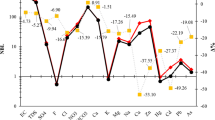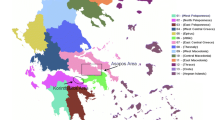Abstract
A series of methods have been applied for evaluating the environmental baseline—especially on a regional scale—because of its importance for local environmental management. However, most of the methods have been statistical in nature, and spatial variability has not been considered simultaneously. In this study, the combined use of statistical and spatial methods has been carried out to analyse lead concentrations in the shallow groundwater in the urban area of Suzhou, northern Anhui Province, China. The environmental baseline of lead in the shallow groundwater has been evaluated to be 3.836–8.240 μg/l after removal of either statistical or spatial outliers. The results are similar to those obtained by model-based objective methods, and further demonstrate that the combination method is more reasonable for environmental baseline evaluation.




Similar content being viewed by others
References
Anselin L (1995) Local indicators of spatial association-LISA. Geogr Anal 27:93–115
CEPA (Chinese Environmental Protection Administration) (1990) Elemental background values of soils in China. Environmental Science Press, Beijing
Darling CTR, Thomas VG (2003) The distribution of outdoor shooting ranges in Ontario and the potential for lead pollution of soil and water. Sci Total Environ 313(1):235–243
Frigge M, Hoaglin DC, Iglewicz B (1989) Some implementations of the Boxplot. Am Stat 43(1):50–54
Gałuszka A (2007) A review of geochemical background concepts and an example using data from Poland. Environ Geol 52(5):861–870
Getis A, Ord JK (1992) The analysis of spatial association by use of distance statistics. Geogr Anal 24:189–206
Goldberg A (1974) Drinking water as a source of lead pollution. Environ Health Perspect 7:103–105
Harries K (2006) Extreme spatial variation in crime density in Baltimore County, MD. Geoforum 37:995–1017
Hawkes HE, Webb JS (1962) Geochemistry in mineral exploration. Harper and Row, New York
Ishioka F, Kurihara K, Suito H, Horikawa Y, Ono Y (2007) Detection of hotspots for three-dimensional spatial data and its application to environmental pollution data. J Environ Sci Sustain Soc 1:15–24
Lark RM (2002) Modeling complex soil properties as contaminated regionalized variables. Geoderma 106:173–190
Laslett GM, Mabratney AB (1990) Further comparison of spatial methods for predicting soil-pH. Soil Sci Soc Am J 54:1553–1558
Li W, Xu B, Song Q, Liu X, Xu J, Brookes PC (2014) The identification of ‘hotspots’ of heavy metal pollution in soil-rice systems at a regional scale in eastern China. Sci Total Environ 472:407–420
Meklit T, Meirvenne MV, Verstraete S, Bonroy J, Tack F (2009) Combining marginal and spatial outlier identification to optimize the mapping of the regional geochemical baseline concentration of soil heavy metals. Geoderma 148:413–420
Nakic Z, Posavec K, Bacani A (2007) A visual basic spreadsheet macro for geochemical background analysis. Ground Water 45(5):642–647
Reimann C, Garrett RG (2005) Geochemical background—concept and reality. Sci Total Environ 350(1):12–27
Salminen R, Tarvainen T (1997) The problem of defining geochemical baselines. A case study of selected elements and geological materials in Finland. J Geochem Explor 60(1):91–98
Sun L, Gui H, Peng W, Lin M (2013) Heavy metals in deep seated groundwater in northern Anhui Province, China: quality and background. Nat Environ Pollut Technol 12(3):533–536
Tango T (1995) A class of tests for detecting ‘general’ and ‘focused’ clustering of rare diseases. Stat Med 14:2323–2334
Urresti-Estala B, Carrasco-Cantos F, Vadillo-Pérez I, Jiménez-Gavilán P (2013) Determination of background levels on water quality of groundwater bodies: a methodological proposal applied to a Mediterranean River basin (Guadalhorce River, Malaga, southern Spain). J Environ Manag 117:121–130
WHO (World Health Organization) (2008) Guidelines for drinking-water quality (3rd edition). World Health Organization, Geneva
Zhang C, McGrath D (2004) Geostatistical and GIS analyses on soil organic carbon concentrations in grassland of southeastern Ireland from two different periods. Geoderma 119:261–275
Zhang C, Luo L, Xu W, Ledwith V (2008) Use of local Moran’s I and GIS to identify pollution hotspots of Pb in urban soils of Galway, Ireland. Sci Total Environ 398:212–221
Acknowledgments
This work was financially supported by the National Natural Science Foundation of China (41302274 and 41173106), and the National College Students Innovation and Entrepreneurship Training Program of China (201210379026).
Author information
Authors and Affiliations
Corresponding author
Rights and permissions
About this article
Cite this article
Sun, L. Environmental baseline evaluation of lead in shallow groundwater based on statistical and spatial outlier identification. Chin. J. Geochem. 34, 416–421 (2015). https://doi.org/10.1007/s11631-015-0050-x
Received:
Revised:
Accepted:
Published:
Issue Date:
DOI: https://doi.org/10.1007/s11631-015-0050-x




